Why we should celebrate the Harry Styles Vogue cover
Harry Styles became the first solo man to grace the cover of American Vogue in its 127-year history this month. Although this was generally met with overwhelming positivity, many have come to criticise his gender neutral experimentation with clothes. Candace Owens demanded the return of “manly men” in one of her tweets and believes “there is no society that can survive without strong men”. But many people came to Styles’ defence. Elijah Wood tweeted “masculinity alone does not make a man… in fact, it’s got nothing to do with it.” Jameela Jamil wrote that “manly is whatever you want it to be” and drew upon the idea of changing masculinities, where fashionable men in the 17th century would have worn tights, make up and wigs.
Owens eventually replied that she is “impervious to woke culture. Showing me 50 examples of something won’t make it any less stupid.” Although her stance is probably guided by her desire to bring attention to her new book, the problem lies beyond that. She perpetuates harmful narratives about gender in her attack on Styles by denying that masculinity is a construct curated over time rather than something biological.
The faster we go forward, the stronger the pull to go backwards
Yet, despite many people coming to Styles’ defence, there were many that voiced support for Owens. I think that is the worrying thing here: not only are people with massive influence over public opinion giving voice to dangerous rhetoric, an overwhelming number of people strongly believe in this harmful ideology. We see it everywhere: the faster we go forward, the stronger the pull to go backwards. People find comfort in what they know – pushing boundaries can be unnerving.
But this type of response is not limited to the US. Piers Morgan is no stranger to controversy, as he is often at odds with modern PC culture. He said Styles looks “weird”, asking: “why does he need to wear a dress?” He misses the point. This is not about need but want. There is an irrational fear of contagion. No one is arguing that men should be forced to wear dresses, but rather to grant them the freedom to do so if they want to. This is about respecting people’s desires and interests. It is not the place of anyone to comment or control the lives of others.
Beyond this idea of gender stereotypes, this is equally artistic expression. Vogue is a fashion magazine, and fashion is about being innovative and playful. These photos are simply a manifestation of that. Vogue holds the highest authority for Western fashion; this cover is very implicit in its decision to show the change regarding masculinity. They are embracing the liberation of clothing identity.
Vogue holds the highest authority for Western fashion; this cover is very implicit in its decision to show the change regarding masculinity
Styles has a history of dressing as gender neutral and experimenting with costume in music videos and concert outfits. He wore a pearl earring to the Met Gala, stacked heels to awards shows and often paints his nails. As a result, he was named the most influential celebrity dresser of 2020. Styles himself said in the Vogue interview that once you look beyond gendered clothing “you open up the arena in which you can play…anytime you’re putting barriers up in your own life, you’re just limiting yourself”.
He’s also not the first music artist to dress with gender neutrality. People have been quick to draw comparisons to Prince, David Bowie, Iggy Pop, and Kurt Cobain – men who played around with gender bending costume throughout the second half of the twentieth century. Equally, there has been criticism that a cis white man has become the face of gender neutral fashion, when there have been many before him that do not fit into those categories, and have contributed more to the movement. Take Marsha P. Johnson, who was instrumental in the transgender movement. Having a man in a dress on the front cover of Vogue is a moment to celebrate, but equally we should be wary of making Styles the face of gender neutral fashion. Criticism here is founded, but does not necessarily invalidate the power of the photo.
The fact that this is even a controversy shows just how much further we have to go and how much we still have to unlearn. There is no danger of toxic masculinity going anywhere anytime soon.

Comments